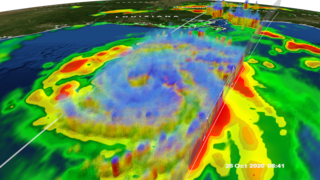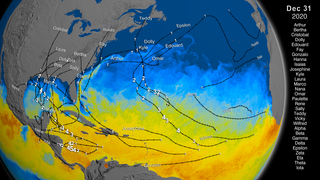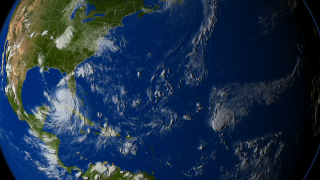Earth
ID: 4869
GPM passed over Tropical Storm Zeta Sunday October 25, 2020 at approximately 2:15pm Central Time (19:15 UTC) as it approached the Yucatan peninsula.
Tropical Storm Zeta is the 27th named storm of 2020 which ties the record for the most named storms since 2005. (See 27 Storms: Arlene to Zeta for a summary of the 2005 hurricane season). With several weeks still left in the 2020 hurricane season, 2020 might well surpass this previous record for most named storms in one season.
Shortly after this data was collected, Zeta briefly reached Hurricane status before turning back into a Tropical Storm as it swept across the Yucatan peninsula. It is currently heading north through the Gulf of Mexico and has re-intensified into a hurricane before making second landfall somewhere on the Gulf coast.
GPM data is archived at https://pps.gsfc.nasa.gov/


NASA/JAXA GPM Satellite Captures Tropical Storm Zeta off the Yucatan Peninsula
There is a newer version of this story located here: https://svs.gsfc.nasa.gov/4870
Tropical Storm Zeta is the 27th named storm of 2020 which ties the record for the most named storms since 2005. (See 27 Storms: Arlene to Zeta for a summary of the 2005 hurricane season). With several weeks still left in the 2020 hurricane season, 2020 might well surpass this previous record for most named storms in one season.
Shortly after this data was collected, Zeta briefly reached Hurricane status before turning back into a Tropical Storm as it swept across the Yucatan peninsula. It is currently heading north through the Gulf of Mexico and has re-intensified into a hurricane before making second landfall somewhere on the Gulf coast.
GPM data is archived at https://pps.gsfc.nasa.gov/


Newer Version
Related
Visualization Credits
Alex Kekesi (Global Science and Technology, Inc.): Lead Data Visualizer
Greg Shirah (NASA/GSFC): Lead Data Visualizer
George Huffman (NASA/GSFC): Lead Scientist
Dalia B Kirschbaum (NASA/GSFC): Scientist
Kathryn Mersmann (USRA): Lead Producer
Ryan Fitzgibbons (USRA): Producer
Katie Jepson (USRA): Producer
Greg Shirah (NASA/GSFC): Lead Data Visualizer
George Huffman (NASA/GSFC): Lead Scientist
Dalia B Kirschbaum (NASA/GSFC): Scientist
Kathryn Mersmann (USRA): Lead Producer
Ryan Fitzgibbons (USRA): Producer
Katie Jepson (USRA): Producer
Please give credit for this item to:
NASA's Scientific Visualization Studio
NASA's Scientific Visualization Studio
Short URL to share this page:
https://svs.gsfc.nasa.gov/4869
Mission:
Global Precipitation Measurement (GPM)
Data Used:
Note: While we identify the data sets used in these visualizations, we do not store any further details nor the data sets themselves on our site.
This item is part of this series:
GPM Animations
Keywords:
DLESE >> Atmospheric science
DLESE >> Hydrology
DLESE >> Natural hazards
SVS >> Tropical Storm
GCMD >> Earth Science >> Atmosphere >> Atmospheric Phenomena >> Hurricanes
GCMD >> Earth Science >> Atmosphere >> Precipitation >> Rain
SVS >> Hyperwall
NASA Science >> Earth
NASA Earth Science Focus Areas >> Weather and Atmospheric Dynamics
GCMD keywords can be found on the Internet with the following citation: Olsen, L.M., G. Major, K. Shein, J. Scialdone, S. Ritz, T. Stevens, M. Morahan, A. Aleman, R. Vogel, S. Leicester, H. Weir, M. Meaux, S. Grebas, C.Solomon, M. Holland, T. Northcutt, R. A. Restrepo, R. Bilodeau, 2013. NASA/Global Change Master Directory (GCMD) Earth Science Keywords. Version 8.0.0.0.0
https://svs.gsfc.nasa.gov/4869
Mission:
Global Precipitation Measurement (GPM)
Data Used:
GPM/GMI/Surface Precipitation also referred to as: Rain Rates
10/25/2020 19:15 - 19:20Z
Credit:
Data provided by the joint NASA/JAXA GPM mission.
Data provided by the joint NASA/JAXA GPM mission.
GPM/DPR/Ku also referred to as: Volumetric Precipitation data
Observed Data - JAXA - 10/25/2020 19:11 - 19:41Z
Credit:
Data provided by the joint NASA/JAXA GPM mission.
Data provided by the joint NASA/JAXA GPM mission.
also referred to as: IMERG
Data Compilation - NASA/GSFC - 10/24/2020 19:11Z - 10/25/2020 19:41ZGOES-16/ABI
10/24/2020 19:11Z - 10/25/2020 19:41Z
Advanced Baseline Imager (ABI) has 16 spectral bands, including two visible channels, four near-infrared channels and ten infrared channels. It is nearly identical to the imagers on Himawari 8 and Himawari 9.
This item is part of this series:
GPM Animations
Keywords:
DLESE >> Atmospheric science
DLESE >> Hydrology
DLESE >> Natural hazards
SVS >> Tropical Storm
GCMD >> Earth Science >> Atmosphere >> Atmospheric Phenomena >> Hurricanes
GCMD >> Earth Science >> Atmosphere >> Precipitation >> Rain
SVS >> Hyperwall
NASA Science >> Earth
NASA Earth Science Focus Areas >> Weather and Atmospheric Dynamics
GCMD keywords can be found on the Internet with the following citation: Olsen, L.M., G. Major, K. Shein, J. Scialdone, S. Ritz, T. Stevens, M. Morahan, A. Aleman, R. Vogel, S. Leicester, H. Weir, M. Meaux, S. Grebas, C.Solomon, M. Holland, T. Northcutt, R. A. Restrepo, R. Bilodeau, 2013. NASA/Global Change Master Directory (GCMD) Earth Science Keywords. Version 8.0.0.0.0














